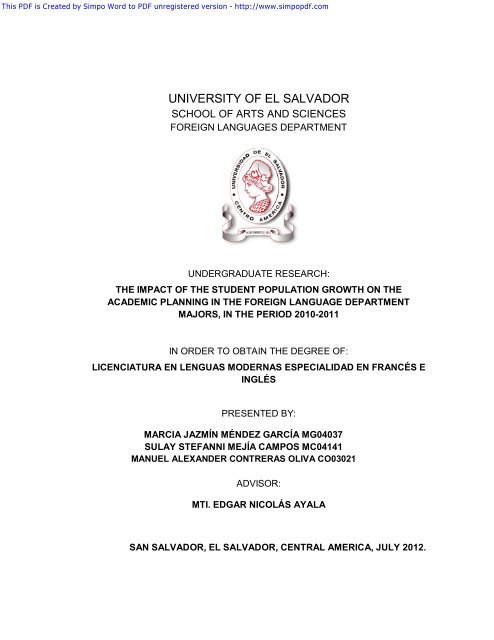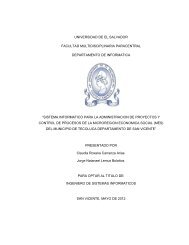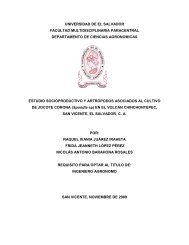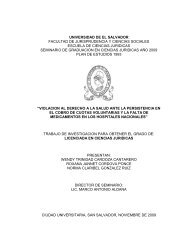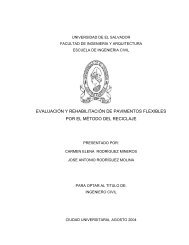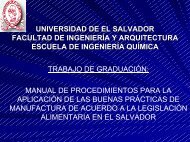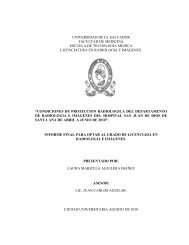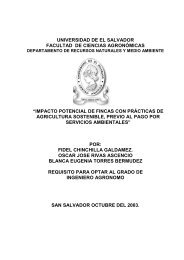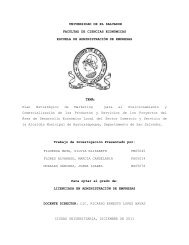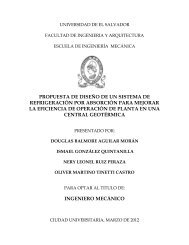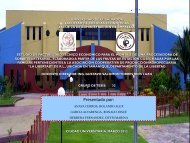UNIVERSITY OF EL SALVADOR - Institutional Repository of the ...
UNIVERSITY OF EL SALVADOR - Institutional Repository of the ...
UNIVERSITY OF EL SALVADOR - Institutional Repository of the ...
Create successful ePaper yourself
Turn your PDF publications into a flip-book with our unique Google optimized e-Paper software.
This PDF is Created by Simpo Word to PDF unregistered version - http://www.simpopdf.comD. Factors that influence on <strong>the</strong> teaching process .......................................16-17E. Academic, administrative, and financial issues regarding <strong>the</strong> growingstudent Population .........................................................................................17-18CHAPTER III: METHODOLOGICAL FRAMEWORKA. Purpose <strong>of</strong> <strong>the</strong> study ...................................................................................... 19B. Sample .......................................................................................................19-20C. Research strategy .......................................................................................... 20D. Field work ........................................................................................................ 211. Researchers2. Data collection techniqueE. Recording and Analyzing data ....................................................................... 21F. Methodological procedure ............................................................................. 22G. Hypo<strong>the</strong>sis ...................................................................................................... 22H. Research design ........................................................................................... 23I. Resources ........................................................................................................ 24J. Budget ............................................................................................................... 24CHAPTER IV: DATA ANALYSISData Analysis diagram .................................................................................................... 25A. Students population growth ......................................................................26-271. Students .........................................................................................27-282. Teachers ........................................................................................28-313. Classrooms ....................................................................................31-334. Furniture .........................................................................................33-345. Technological resources................................................................34-356. Schedules ........................................................................................... 357. Buildings ..........................................................................................35-40
This PDF is Created by Simpo Word to PDF unregistered version - http://www.simpopdf.comThe second chapter is devoted to data ga<strong>the</strong>ring and analysis. Researchersused interviews addressed to school authorities, Foreign LanguageDepartment authorities and a survey administered to freshman students (firstyear) who just began studies in 2011.The third chapter deals with conclusions and suggestions. They are intendedto highlight main findings and raise awareness on <strong>the</strong> sensible andcontroversial topic; moreover, researchers expect authorities to pay moreattention to <strong>the</strong> problem and craft out solutions.iii
This PDF is Created by Simpo Word to PDF unregistered version - http://www.simpopdf.com_____________________________________________________I. RESEARCH DESIGNA) Statement <strong>of</strong> <strong>the</strong> problemThe impact <strong>of</strong> student population growth on Academic Planning in <strong>the</strong>Foreign Language Department majors in <strong>the</strong> period 2010-2011.B) Objectives1. General ObjectiveTo determine how <strong>the</strong> impact <strong>of</strong> <strong>the</strong> student population growth isaffecting <strong>the</strong> Academic Planning in <strong>the</strong> Foreign LanguageDepartment (FLD) majors through an Explorative andComparative research in <strong>the</strong> period 2010-2011.2. Specific Objectivea. To explore <strong>the</strong> causes <strong>of</strong> student population growth in <strong>the</strong>academic planning in Foreign Language Department majorsand its effects in <strong>the</strong> period 2010-2011 through in-depthinterviews and a survey.b. To diagnose if <strong>the</strong> authorities <strong>of</strong> <strong>the</strong> Foreign LanguageDepartment are capable <strong>of</strong> dealing with this phenomenon byaddressing in-depth interviews to <strong>the</strong> head, majorcoordinators and pr<strong>of</strong>essors <strong>of</strong> <strong>the</strong> FLD.c. To determine if <strong>the</strong>re are enough human resources(teachers) to handle <strong>the</strong> student population growth in <strong>the</strong>1
This PDF is Created by Simpo Word to PDF unregistered version - http://www.simpopdf.comclassroom by interviewing teachers, major coordinators and<strong>the</strong> head <strong>of</strong> <strong>the</strong> FLD.d. To verify if <strong>the</strong>re are enough classrooms to teach scheduledclasses in FLD through information provided by <strong>the</strong>Academic Administration.e. To study if <strong>the</strong> schedules are adequate for <strong>the</strong> students <strong>of</strong>Foreign Language Department majors by administrating asurvey among students and teachers.f. To determine if <strong>the</strong>re are appropriate and enoughtechnological resources for <strong>the</strong> students and teachers fromForeign Language Department majors throughdocumentation provided by <strong>the</strong> authorities, teachers andstudents <strong>of</strong> <strong>the</strong> FLD.g. To verify if <strong>the</strong>re is appropriate and enough furniture tocover all groups from <strong>the</strong> different subjects in ForeignLanguage Department majors by videotaping classes.h. To write some recommendations that can help <strong>the</strong>authorities <strong>of</strong> <strong>the</strong> Foreign Language Department to face thisphenomenon based on <strong>the</strong> final research results findings.2
This PDF is Created by Simpo Word to PDF unregistered version - http://www.simpopdf.comC) Research questions1. How <strong>the</strong> high demand <strong>of</strong> students was affecting <strong>the</strong> AcademicPlanning in <strong>the</strong> areas <strong>of</strong> teachers, classrooms, schedules,technology, furniture, in Foreign Language Department majorsin <strong>the</strong> period 2010-2011?2. Which were <strong>the</strong> causes <strong>of</strong> <strong>the</strong> increase <strong>of</strong> students in Foreignlanguage Department majors?3. Were <strong>the</strong> authorities <strong>of</strong> <strong>the</strong> Foreign Language Departmentcapable <strong>of</strong> dealing with this phenomenon?4. Were <strong>the</strong>re enough human resources (teachers) to handle <strong>the</strong>high demand <strong>of</strong> students in Foreign Language Departmentmajors?5. Were <strong>the</strong> schedules acceptable for <strong>the</strong> students <strong>of</strong> ForeignLanguage Department majors?6. Were <strong>the</strong>re appropriate technological resources for <strong>the</strong> studentsand teachers from Foreign Language Department majors?7. Was <strong>the</strong>re enough furniture in <strong>the</strong> classrooms?8. Were <strong>the</strong>re enough classrooms to teach scheduled classes?3
This PDF is Created by Simpo Word to PDF unregistered version - http://www.simpopdf.comD) Justification <strong>of</strong> <strong>the</strong> ResearchThe significance <strong>of</strong> this research project was to know <strong>the</strong> impact <strong>of</strong>student population growth on <strong>the</strong> Academic Planning in <strong>the</strong> ForeignLanguage Department (FLD).First, this research aimed at determining if <strong>the</strong> quality <strong>of</strong> educationwas being affected by <strong>the</strong> amount <strong>of</strong> students per class, <strong>the</strong> quantity <strong>of</strong>furniture, space, technological, and human resources that were used inorder to supply <strong>the</strong> needs <strong>of</strong> <strong>the</strong> Foreign Language Department majors.Second, it explored if <strong>the</strong> authorities <strong>of</strong> <strong>the</strong> Foreign Language Departmentwere aware <strong>of</strong> <strong>the</strong> situation that students and teachers have beenexposed to, in a direct way to student population growth. This researchstudied if <strong>the</strong> schedules were adequate for students and teachers.Therefore, <strong>the</strong> authorities <strong>of</strong> <strong>the</strong> FLD took this research results to followand determine if <strong>the</strong>re were more advantages than disadvantages relatedto student population growth. In addition, this research had for objectiveto investigate if <strong>the</strong>re was enough furniture, human resources, andmethodological resources to supply <strong>the</strong> needs <strong>of</strong> students and teachers in<strong>the</strong> FLD, since a better environment and <strong>the</strong> enough furniture helps to abetter teaching and learning process.Moreover, this research will benefit <strong>the</strong> authorities, students, andteachers <strong>of</strong> <strong>the</strong> FLD by helping <strong>the</strong>m to better understand <strong>the</strong> topic, to seeif <strong>the</strong>re is a fair distribution <strong>of</strong> students per classroom, enough teachingmaterial and realia per number <strong>of</strong> students and teachers in order toimplement a good teaching-learning process.4
This PDF is Created by Simpo Word to PDF unregistered version - http://www.simpopdf.comFinally, this research will serve as a reference for fur<strong>the</strong>r studies on<strong>the</strong> subject matter. In addition, it will serve students, teachers, authoritiesand researchers to perceive how student population growth is impactingon <strong>the</strong> academic planning and <strong>the</strong>refore, teachers and students.This research was developed with in-depth interviews, transcriptions,audio, videos, photographs and surveys which were given to <strong>the</strong>authorities, pr<strong>of</strong>essors and students <strong>of</strong> <strong>the</strong> FLD.5
This PDF is Created by Simpo Word to PDF unregistered version - http://www.simpopdf.com_____________________________________________________II.THEORETICAL FRAMEWORKA. THE SCHOOL ORGANIZATIONSchools are simultaneously two things: institutions and organizations;as institutions will have a legal status, with governors or shareholders, aboard <strong>of</strong> management, staff and students. The school will have to conform towhatever legal requirements are laid down for institutions, and it will normallybe registered with <strong>the</strong> appropriate authority 1 .Schools as organizations consist <strong>of</strong> a network <strong>of</strong> relationships among<strong>the</strong> individuals who regard <strong>the</strong>mselves as belonging to that organization.These relationships will be variously directed towards <strong>the</strong> achievement <strong>of</strong> <strong>the</strong>goals <strong>of</strong> <strong>the</strong> organization, towards maintaining <strong>the</strong> organization as a socialunit, and towards fulfilling <strong>the</strong> personal needs <strong>of</strong> <strong>the</strong> individuals. Schools haveno existence o<strong>the</strong>r than through <strong>the</strong> people who make <strong>the</strong>m up; it is possibleto describe <strong>the</strong> relationships among <strong>the</strong>ir members in terms <strong>of</strong> structures andfunctions. Because without students, a school has no existence as a livingand functioning organization, even if it may still have a legal existence as aninstitution 2 .The vital aspect <strong>of</strong> an organization is technology. It constitutes <strong>the</strong>means by which various operations are carried out in <strong>the</strong> pursuit <strong>of</strong>organizational goals. An important part <strong>of</strong> organizational technology is <strong>the</strong>communication systems which enable information to be circulated aroundmembers <strong>of</strong> <strong>the</strong> organization. Ano<strong>the</strong>r important part <strong>of</strong> <strong>the</strong> educationaltechnology <strong>of</strong> a school is <strong>the</strong> curriculum itself which embodies not only <strong>the</strong>pedagogical aims <strong>of</strong> <strong>the</strong> school but <strong>the</strong> methods and materials employed inrealizing those aims. In short, <strong>the</strong> technology <strong>of</strong> an organization consists <strong>of</strong>1.CONDUCIENDO LA ESCU<strong>EL</strong>A. D<strong>EL</strong>LA AZZERBONI AND RUTH HARF. 2003. P: 24-252. Idem6
This PDF is Created by Simpo Word to PDF unregistered version - http://www.simpopdf.comboth tangible and intangible what means whereby organizational goals can beachieved 3 .As an organization, a school will have to fulfill and maintain in balancethree broad sets <strong>of</strong> needs: task needs, group needs, and individual needs.The task needs are those which have to be satisfied in order successfully tocarry out <strong>the</strong> work <strong>of</strong> <strong>the</strong> organization. For instance, a private languageschool, one <strong>of</strong> its goals will be to stay in business, and to generate a pr<strong>of</strong>it. Toachieve this, students will have to be recruited, so marketing and selling <strong>the</strong>school services will be a key task, which will involve planning a marketingstrategy, allocating work to people assigned to marketing, and providingfinance. The second sets <strong>of</strong> needs, those concerned with <strong>the</strong> groups, are todo with <strong>the</strong> organization as a social unit. For <strong>the</strong> organization to meet taskneeds, successful group maintenance is vital, because it becomes split intoantagonistic factions.For instance, a school with a particularly dedicated staff may have veryhigh expectations to staff as regards <strong>the</strong> amount <strong>of</strong> time <strong>the</strong>y devote to out <strong>of</strong>class activities. Teachers who give less time to such activities will be seen tohave infringed work standards and <strong>the</strong> group may impose some sort <strong>of</strong>pressure, or discipline on <strong>the</strong> teachers concerned to bring <strong>the</strong>m into line withgroup norms in this aspect <strong>of</strong> <strong>the</strong>ir work.The successful creation and maintenance <strong>of</strong> team spirit is alsoimportant and it is a mark <strong>of</strong> a successful organization that this social need isfulfilled. A happy and harmonious staff room is one sign that such groupmaintenance needs are being met, while such activities as meeting for a drinkafter work are fur<strong>the</strong>r examples <strong>of</strong> <strong>the</strong> same thing. Finally, <strong>the</strong>re is a third set<strong>of</strong> needs which have to be met, individual or personal needs. If <strong>the</strong>y are notmet, <strong>the</strong>re will be a loss <strong>of</strong> morale and motivation among <strong>the</strong> individuals who3. Idem7
This PDF is Created by Simpo Word to PDF unregistered version - http://www.simpopdf.commajor, if it was his first choice, if it was a change <strong>of</strong> major, or for <strong>the</strong>lack <strong>of</strong> vacancy in ano<strong>the</strong>r major 13 .b. Complexity <strong>of</strong> <strong>the</strong> major: it refers to <strong>the</strong> difficulty <strong>of</strong> some subjects<strong>of</strong> <strong>the</strong> different majors or academic areas that usually <strong>the</strong>universities classify <strong>the</strong>m based on statistics <strong>of</strong> those subjects witha high level <strong>of</strong> failure 14 .c. <strong>Institutional</strong> conditions: <strong>the</strong> students can see <strong>the</strong>ir academicperformance affected with aspects related to <strong>the</strong> university itself;elements like <strong>the</strong> condition <strong>of</strong> <strong>the</strong> classrooms, technologicalservices, academic planning, schedules and <strong>the</strong> competence <strong>of</strong> <strong>the</strong>teaching staff, <strong>the</strong>y appear to be boundaries <strong>of</strong> <strong>the</strong> academicperformance but also can be facilitators 15 .d. <strong>Institutional</strong> services <strong>of</strong> support: it refers to all those servicesthat <strong>the</strong> institution <strong>of</strong>fers to <strong>the</strong> students according to <strong>the</strong>ir economiccondition; for example: scholarships, library service, medicalassistance, and psychological support, among o<strong>the</strong>rs 16 .e. Student environment: An environment marked by an excessivecompetitiveness and amount <strong>of</strong> classmates can act as a limitationor as a facilitator <strong>of</strong> <strong>the</strong> academic performance. It is outlined that<strong>the</strong> solidarity, <strong>the</strong> companionship, and <strong>the</strong> social support areimportant elements that also affect <strong>the</strong> academic performance <strong>of</strong><strong>the</strong> students 17 .13. Idem p. 814. Idem p. 815. Idem p. 816. Idem p. 817. Idem p. 812
This PDF is Created by Simpo Word to PDF unregistered version - http://www.simpopdf.com_____________________________________________________III.METHODOLOGICAL FRAMEWORKA. PURPOSE <strong>OF</strong> THE STUDYThe purpose <strong>of</strong> this study was to explore, diagnose, compare andanalyze <strong>the</strong> emerging impact <strong>of</strong> student population growth on <strong>the</strong> AcademicPlanning in <strong>the</strong> FLD majors. This research was exploratory and comparativesince it related information and data from <strong>the</strong> FLD majors applying <strong>the</strong>existing literature, due to <strong>the</strong> fact that <strong>the</strong>re were previous studies on thisphenomenon. These studies, however, were scattered across variousstreams <strong>of</strong> research and thus it needed to be ga<strong>the</strong>red and elaborated insuch a form that it could be applied in <strong>the</strong> analysis <strong>of</strong> <strong>the</strong> studiedphenomenon.B. SAMPLEThe chosen sample for <strong>the</strong> research project were <strong>the</strong> authorities, majorcoordinators, teachers, and students from <strong>the</strong> FLD <strong>of</strong> <strong>the</strong> School <strong>of</strong> Arts andSciences <strong>of</strong> <strong>the</strong> University <strong>of</strong> El Salvador, which was constituted <strong>of</strong> 60Students, 6 Teachers, 3 Major Coordinators and 5 heads <strong>of</strong> <strong>the</strong> FLD and <strong>the</strong>Administrative and Financial Administrators because <strong>the</strong>y were facing <strong>the</strong>impact <strong>of</strong> <strong>the</strong> student population growth and this made <strong>the</strong>m bettercandidates to answer <strong>the</strong> questions related to <strong>the</strong> topic.1. SAMPLING PROCEDURENon-probabilistic samplinga. By criteriaStudents and pr<strong>of</strong>essors:19
This PDF is Created by Simpo Word to PDF unregistered version - http://www.simpopdf.comH. RESEARCH DESIGN23
This PDF is Created by Simpo Word to PDF unregistered version - http://www.simpopdf.com_____________________________________________________IV.DATA ANALYSIS25
This PDF is Created by Simpo Word to PDF unregistered version - http://www.simpopdf.comagree that in <strong>the</strong> latest years <strong>the</strong> student population <strong>of</strong> <strong>the</strong> University <strong>of</strong> ElSalvador has been increasing more and more up to <strong>the</strong> point that now UESdoes not have more space to accommodate big groups <strong>of</strong> students.In spite <strong>of</strong> <strong>the</strong> efforts made by <strong>the</strong> authorities <strong>of</strong> <strong>the</strong> University, <strong>the</strong>y still donot manage to cover completely <strong>the</strong> demand <strong>of</strong> students that <strong>the</strong>y havenowadays, a simple example is <strong>the</strong> Arts and Sciences School with <strong>the</strong>Foreign Language Department which has 1, 587 students per semester witha total cost per every student <strong>of</strong> $188.15; information provided in <strong>the</strong> interviewwith <strong>the</strong> Financial Administrator <strong>of</strong> <strong>the</strong> School <strong>of</strong> Arts and Sciences <strong>of</strong> TheUniversity <strong>of</strong> El Salvador Lic. Romeo Alfredo Merino.In agreement with <strong>the</strong> information, <strong>the</strong> Foreign Language Department hasa teaching staff <strong>of</strong> 44 teachers, 38 working full time and 6 part time, besides 4people being employed at <strong>the</strong> administrative area, making a total in <strong>the</strong>payroll <strong>of</strong> $62,279.43. The head <strong>of</strong> <strong>the</strong> FLD has requested full time teacherhiring in order to fulfill <strong>the</strong> necessities <strong>the</strong> Department has, but <strong>the</strong> budget hasnot been approved by <strong>the</strong> authorities <strong>of</strong> <strong>the</strong> Arts and Sciences School. Thereason why some <strong>of</strong> <strong>the</strong> requests made by <strong>the</strong> different Schools andDepartments are not approved is due to <strong>the</strong> reason that <strong>the</strong> budget that isgiven to <strong>the</strong> School is not enough to fulfill all <strong>the</strong> request and necessities that<strong>the</strong> different schools and Departments make every period.According to Licenciado Merino, <strong>the</strong> School <strong>of</strong> Arts and Sciences receives ageneral budget <strong>of</strong> $5.031,240 <strong>of</strong> which $106,985 are destined to <strong>the</strong> normalfunctioning <strong>of</strong> every Department and Schools <strong>of</strong> <strong>the</strong> School <strong>of</strong> Arts andSciences, which is used for <strong>the</strong> payment <strong>of</strong> teachers' wages among all <strong>the</strong>Departments, leaving aside o<strong>the</strong>r investments that each one suffers forexample, paper, materials <strong>of</strong> work for <strong>the</strong> teachers, etc.38
This PDF is Created by Simpo Word to PDF unregistered version - http://www.simpopdf.comAt <strong>the</strong> same time, it demonstrates that economically speaking bigquantities <strong>of</strong> students favors <strong>the</strong> University since <strong>the</strong> costs for Departmentreduce; but on <strong>the</strong> o<strong>the</strong>r hand, it is negative for <strong>the</strong> academic quality thatstudents receive.The Arts and Sciences School has invested a total <strong>of</strong> $209,102.94 inequipment and furniture for <strong>the</strong> School, at <strong>the</strong> same time a total <strong>of</strong> $17,262.98<strong>of</strong> investment in schools and libraries. In addition, an investment for <strong>the</strong> hiring<strong>of</strong> a teaching staff for pr<strong>of</strong>essional services not personnel and additional timefor <strong>the</strong> semester I <strong>of</strong> <strong>the</strong> years 2009, 2010 and 2011, <strong>of</strong> which in 2009 $71,492.78, in 2010 $85, 939.47 and in 2011 $133, 272.80 were invested, it ispossible to clearly observe that <strong>the</strong> expenses have increased enough in <strong>the</strong>last three years 40 .The FLD authorities have been supplying <strong>the</strong> necessities <strong>of</strong> <strong>the</strong>students as much as <strong>the</strong>y can with <strong>the</strong> hiring <strong>of</strong> teachers per hour and <strong>the</strong>current staff <strong>the</strong>y have; in addition, with <strong>the</strong> acquisition <strong>of</strong> technologicalresources like projectors, laptops, c.d. players, computers, and books.According to <strong>the</strong> Heads <strong>of</strong> <strong>the</strong> Education Department and JournalismDepartment <strong>the</strong> authorities <strong>of</strong> <strong>the</strong> FLD have been fighting every year <strong>the</strong> highdemand <strong>of</strong> students who want to study a Language major and <strong>the</strong>y have seen<strong>the</strong> efforts that <strong>the</strong> Head <strong>of</strong> <strong>the</strong> FLD has done towards <strong>the</strong> big amount <strong>of</strong>students <strong>the</strong> Department is getting every year.The authorities <strong>of</strong> <strong>the</strong> FLD have presented to <strong>the</strong> Board <strong>of</strong>Management <strong>of</strong> <strong>the</strong> Arts and Sciences School an explanation why <strong>the</strong> FLDcannot handle more students and have made some request like: Morebuildings, more teachers, more budget, in conclusion <strong>the</strong> minimum conditionsrequired for a good teaching-learning process for big amounts <strong>of</strong> students.Never<strong>the</strong>less, <strong>the</strong> Board <strong>of</strong> Management did not accept <strong>the</strong>ir request40. see appendix F, page 1.39
This PDF is Created by Simpo Word to PDF unregistered version - http://www.simpopdf.combecause <strong>the</strong> budget <strong>the</strong> University receives every year do not allow to makethis kind <strong>of</strong> changes in a short period; that is why <strong>the</strong> FLD made <strong>the</strong> decision<strong>of</strong> not accepting those students who do not approved <strong>the</strong> Admission test.40
This PDF is Created by Simpo Word to PDF unregistered version - http://www.simpopdf.com5- In order to conclude, most <strong>of</strong> <strong>the</strong> interviewers believe that classroomsare not comfortable for <strong>the</strong> teaching-learning process <strong>the</strong>y said that<strong>the</strong> classrooms were not designed for <strong>the</strong> teaching activity, <strong>the</strong>y statethat <strong>the</strong>y were <strong>the</strong> university dorms; <strong>the</strong> authorities have tried toaccommodate <strong>the</strong>m but <strong>the</strong> size is not uniform, because <strong>the</strong>re aresome that are bigger and o<strong>the</strong>rs that are smaller and in some <strong>of</strong> <strong>the</strong>m itis seen that <strong>the</strong> columns <strong>of</strong> <strong>the</strong> buildings interfere when <strong>the</strong> class isbeing developed. In addition, semester after semester <strong>the</strong>re is lack <strong>of</strong>classrooms that have to be settled with <strong>the</strong> ones <strong>the</strong> School <strong>of</strong> Arts andSciences has; something <strong>the</strong>y do is going to o<strong>the</strong>r Schools in order tolook for classrooms for example Psychology or Medicine.Finally, it was possible to realize that despite efforts that Authorities <strong>of</strong><strong>the</strong> FLD have done, <strong>the</strong> student population growth generates a huge andmostly a negative impact in <strong>the</strong> academic planning <strong>of</strong> <strong>the</strong> FLD.B. SUGGESTIONS1. For <strong>the</strong> Authorities <strong>of</strong> <strong>the</strong> Arts and Sciences School:a. The admission for students who apply to a change <strong>of</strong> majorto any <strong>of</strong> <strong>the</strong> majors <strong>of</strong> <strong>the</strong> FLD needs more controlled.b. To look for <strong>the</strong> cooperation <strong>of</strong> o<strong>the</strong>r entities that can help toobtain <strong>the</strong> equipment to begin <strong>the</strong> project <strong>of</strong> semi-presentialeducation.c. To demand for more budget to build new buildings and moreclassrooms.44
This PDF is Created by Simpo Word to PDF unregistered version - http://www.simpopdf.comd. To focus on <strong>the</strong> hiring <strong>of</strong> more full-time teachers instead <strong>of</strong>teachers hired on an hourly-basis.2. For <strong>the</strong> Authorities <strong>of</strong> <strong>the</strong> Foreign Language Department:a. It is essential to have less number <strong>of</strong> students per class toprovide <strong>the</strong>m more attention in <strong>the</strong> classroom.b. It is important to implement frequent training for teachers inorder for <strong>the</strong>m to use new technologies.c. It is vital to continue having good relationships with entitieslike <strong>the</strong> Embassy <strong>of</strong> <strong>the</strong> United States <strong>of</strong> America, Franceand Japan in order to continue having Multilanguageexchanges, donations <strong>of</strong> books, technological resources,etc.d. It is crucial to extend <strong>the</strong> schedule <strong>of</strong> <strong>the</strong> lab center - eighthours a day - so <strong>the</strong> students can take advantage <strong>of</strong> <strong>the</strong>new technological resources available.3. For <strong>the</strong> Teachers <strong>of</strong> <strong>the</strong> Foreign Language Department:a. To update with new technologies in order to modernize<strong>the</strong> teaching process.b. To care about <strong>the</strong> phenomenon <strong>the</strong> FLD is facing with <strong>the</strong>student population growth and participate in an activeway by proposing ideas in order to solve <strong>the</strong> problem.45
This PDF is Created by Simpo Word to PDF unregistered version - http://www.simpopdf.comAPPENDIX A- 1Universidad de El SalvadorFacultad de Ciencias y HumanidadesDepartamento de Idiomas ExtranjerosOBJECTIVE: To investigate <strong>the</strong> impact <strong>of</strong> <strong>the</strong> student population growth on <strong>the</strong> students <strong>of</strong><strong>the</strong> FLD in <strong>the</strong> academic field, in <strong>the</strong> period 2010-2011.Graphic ISource: Survey administered to <strong>the</strong> first year students on <strong>the</strong> year 2011 in FLD.The bar chart shows <strong>the</strong> number <strong>of</strong> men and women in <strong>the</strong> FLD <strong>of</strong> <strong>the</strong> Academic Year 2011.It can be clearly seen in <strong>the</strong> chart that <strong>the</strong> proportion <strong>of</strong> women is much higher than <strong>the</strong>proportion <strong>of</strong> men. Since, <strong>the</strong> female population represents <strong>the</strong> 58,3% and <strong>the</strong> malepopulation <strong>the</strong> 41,7%.Graphic IISource: Survey administered to <strong>the</strong> first year students on <strong>the</strong> year 2011 in FLD.The bar chart shows <strong>the</strong> different ages <strong>of</strong> <strong>the</strong> surveyed students in <strong>the</strong> FLD <strong>of</strong> <strong>the</strong> AcademicYear 2011. It can be clearly seen in <strong>the</strong> chart that <strong>the</strong> young population with an average age
This PDF is Created by Simpo Word to PDF unregistered version - http://www.simpopdf.comAPPENDIX A-3Graphic VSource: Survey administered to <strong>the</strong> first year students on <strong>the</strong> year 2011 in FLD.The bar chart shows <strong>the</strong> established schedules to <strong>the</strong> students <strong>of</strong> <strong>the</strong> FLD <strong>of</strong> <strong>the</strong> AcademicYear 2011. It is noticeably in <strong>the</strong> chart that <strong>the</strong> Morning shift represents <strong>the</strong> 73,3%; oppositeto <strong>the</strong> afternoon shift which represents <strong>the</strong> 10,0% <strong>of</strong> <strong>the</strong> general student population.Graphic VISource: Survey administered to <strong>the</strong> first year students on <strong>the</strong> year 2011 in FLD.This bar chart shows <strong>the</strong> number <strong>of</strong> subjects taken by <strong>the</strong> surveyed students in <strong>the</strong> FLD <strong>of</strong><strong>the</strong> Academic Year 2011. It is markedly shown in <strong>the</strong> chart that <strong>the</strong> 48,3% <strong>of</strong> students aretaken 3 subjects; in contrast with <strong>the</strong> 5% percent <strong>of</strong> students who are taking 2 subjects <strong>of</strong> <strong>the</strong>general student population.
This PDF is Created by Simpo Word to PDF unregistered version - http://www.simpopdf.comAPPENDIX A- 4Graphic VIISource: Survey administered to <strong>the</strong> first year students on <strong>the</strong> year 2011 in FLD.The bar chart shows <strong>the</strong> number <strong>of</strong> students per class <strong>of</strong> <strong>the</strong> surveyed students in <strong>the</strong> FLD <strong>of</strong><strong>the</strong> Academic Year 2011. It is visibly in <strong>the</strong> chart that <strong>the</strong> 65% <strong>of</strong> students agreed that <strong>the</strong>reare more than 35 students in class; in contrast with an 8, 3% who agreed that in <strong>the</strong>irclassroom are approximately 15 students.Graphic VIIISource: Survey administered to <strong>the</strong> first year students on <strong>the</strong> year 2011 in FLD.The bar chart shows <strong>the</strong> percentage <strong>of</strong> teachers giving advisories according to <strong>the</strong> surveyedstudents in <strong>the</strong> FLD <strong>of</strong> <strong>the</strong> Academic Year 2011. The 55% <strong>of</strong> teachers give advisories tostudents; in contrast with <strong>the</strong> 45% <strong>of</strong> teachers do not give advisories to students.
This PDF is Created by Simpo Word to PDF unregistered version - http://www.simpopdf.comAPPENDIX A-5Graphic IXSource: Survey administered to <strong>the</strong> first year students on <strong>the</strong> year 2011 in FLD.The bar chart shows <strong>the</strong> number <strong>of</strong> advisories students received per week in <strong>the</strong> FLD <strong>of</strong> <strong>the</strong>Academic Year 2011. It is visibly in <strong>the</strong> chart that <strong>the</strong> 33,3% <strong>of</strong> students received 1 advisoryin <strong>the</strong> week; in contrast with <strong>the</strong> 41,7% <strong>of</strong> students who do not receive any advisory in <strong>the</strong>week.Graphic XSource: Survey administered to <strong>the</strong> first year students on <strong>the</strong> year 2011 in FLD.The bar chart shows <strong>the</strong> importance <strong>of</strong> advisories to <strong>the</strong> surveyed students in <strong>the</strong> FLD <strong>of</strong> <strong>the</strong>Academic Year 2011. It is markedly seen in <strong>the</strong> chart that <strong>the</strong> 100% <strong>of</strong> students consideredadvisories important for <strong>the</strong> learning process.
This PDF is Created by Simpo Word to PDF unregistered version - http://www.simpopdf.comGraphic XIIIAPPENDIX A- 7Source: Survey administered to <strong>the</strong> first year students on <strong>the</strong> year 2011 in FLD.The bar chart shows <strong>the</strong> amount <strong>of</strong> students that consider that in <strong>the</strong> FLD sometimes <strong>the</strong>reare enough desks available for <strong>the</strong> student population <strong>the</strong>y represent 43% in contrast <strong>of</strong>26% that think that <strong>the</strong>re are enough and with 30% that say <strong>the</strong>re are not enough desks in<strong>the</strong> FLD.Graphic XIVSource: Survey administered to <strong>the</strong> first year students on <strong>the</strong> year 2011 in FLD.The bar chart shows <strong>the</strong> amount <strong>of</strong> students that don not attend classes for <strong>the</strong> lack <strong>of</strong> desksin <strong>the</strong> classroom in <strong>the</strong> FLD. The people who does not attend classes is <strong>the</strong> 20,0% in contrastwith <strong>the</strong> ones who attend that represents <strong>the</strong> 78,3%.
This PDF is Created by Simpo Word to PDF unregistered version - http://www.simpopdf.comGraphic XVAPPENDIX A- 8Source: Survey administered to <strong>the</strong> first year students on <strong>the</strong> year 2011 in FLD.The bar chart shows that 56% <strong>of</strong> <strong>the</strong> surveyed students in <strong>the</strong> FLD <strong>of</strong> <strong>the</strong> Academic Year2011 have classes in ano<strong>the</strong>r building also it is visibly in <strong>the</strong> chart that 43.3% do not have anyclass in ano<strong>the</strong>r building.Graphic XVISource: Survey administered to <strong>the</strong> first year students on <strong>the</strong> year 2011 in FLD.The bar chart shows that <strong>the</strong> 23.3% <strong>of</strong> <strong>the</strong> surveyed students in <strong>the</strong> FLD <strong>of</strong> <strong>the</strong> AcademicYear 2011 consider that <strong>the</strong>y have enough time to move from one building to ano<strong>the</strong>r It isvisibly also that <strong>the</strong> same percentage 23.3% consider that <strong>the</strong>y do not have enough time tomove.
This PDF is Created by Simpo Word to PDF unregistered version - http://www.simpopdf.comAPPENDIX A-9Graphic XVIISource: Survey administered to <strong>the</strong> first year students on <strong>the</strong> year 2011 in FLD.The bar chart shows that 63% <strong>of</strong> <strong>the</strong> surveyed students in <strong>the</strong> FLD <strong>of</strong> <strong>the</strong> Academic Year2011 consider that teachers do not provide solutions for lack <strong>of</strong> desks in <strong>the</strong> class in <strong>the</strong>opposite <strong>of</strong> 35% that consider that teachers provide effective solutions to <strong>the</strong> problematic.Graphic XVIIISource: Survey administered to <strong>the</strong> first year students on <strong>the</strong> year 2011 in FLD.The bar chart shows that 60% <strong>of</strong> <strong>the</strong> surveyed students in <strong>the</strong> FLD <strong>of</strong> <strong>the</strong> Academic Year2011 consider that classrooms are not spacious enough in contrast <strong>of</strong> 40% that consider thatclassrooms in <strong>the</strong> FLD have enough space to supply students needs .
This PDF is Created by Simpo Word to PDF unregistered version - http://www.simpopdf.comGraphic XIXAPPENDIX A-10Source: Survey administered to <strong>the</strong> first year students on <strong>the</strong> year 2011 in FLD.The bar chart shows that 88, 3% <strong>of</strong> <strong>the</strong> surveyed students in <strong>the</strong> FLD <strong>of</strong> <strong>the</strong> Academic Year2011 consider that classrooms are not well-equipped and arranged also is visibly in <strong>the</strong>chart that 11.7% <strong>of</strong> surveyed students think that classrooms are well equipped and arrangedGraphic XXSource: Survey administered to <strong>the</strong> first year students on <strong>the</strong> year 2011 in FLD.The bar chart shows that 85.0% <strong>of</strong> <strong>the</strong> surveyed students in <strong>the</strong> FLD <strong>of</strong> <strong>the</strong> Academic Year2011 consider that <strong>the</strong>re are not enough classrooms in <strong>the</strong> FLD to supply students needsalso It is visibly in <strong>the</strong> chart that 15.0% <strong>of</strong> surveyed students consider that in <strong>the</strong> FLD <strong>the</strong>reare enough classrooms available for <strong>the</strong> student population.
This PDF is Created by Simpo Word to PDF unregistered version - http://www.simpopdf.comGraphic XXIIIAPPENDIX A- 12Source: Survey administered to <strong>the</strong> first year students on <strong>the</strong> year 2011 in FLD.The bar chart shows that 85% <strong>of</strong> <strong>the</strong> surveyed students in <strong>the</strong> FLD <strong>of</strong> <strong>the</strong> Academic Year2011 have only one class with <strong>the</strong> same teacher It is visibly in <strong>the</strong> chart also that 15% havetwo different classes with <strong>the</strong> same teacher.Graphic XXIVSource: Survey administered to <strong>the</strong> first year students on <strong>the</strong> year 2011 in FLD.The bar chart shows that 95.0% <strong>of</strong> <strong>the</strong> surveyed students in <strong>the</strong> FLD <strong>of</strong> <strong>the</strong> Academic Year2011 consider that having more teachers in <strong>the</strong> FLD more schedule availability It is visibly in<strong>the</strong> chart also that 5,0% <strong>of</strong> surveyed students think in an opposite way.
This PDF is Created by Simpo Word to PDF unregistered version - http://www.simpopdf.comAPPENDIX A- 13Graphic XXVSource: Survey administered to <strong>the</strong> first year students on <strong>the</strong> year 2011 in FLD.The bar chart shows that 66,7% <strong>of</strong> <strong>the</strong> surveyed students in <strong>the</strong> FLD <strong>of</strong> <strong>the</strong> Academic Year2011 consider that schedules are convenient for <strong>the</strong>m also It is visibly in <strong>the</strong> chart that 33.3%have a different point <strong>of</strong> view about it.Graphic XXVISource: Survey administered to <strong>the</strong> first year students on <strong>the</strong> year 2011 in FLD.The bar chart shows that 91.7% <strong>of</strong> <strong>the</strong> surveyed students in <strong>the</strong> FLD <strong>of</strong> <strong>the</strong> Academic Year2011 do not know about any project developed by <strong>the</strong> authorities <strong>of</strong> <strong>the</strong> FLD to organizecited department also it is visibly in <strong>the</strong> chart that 8.3% <strong>of</strong> surveyed students already knowabout projects developed by <strong>the</strong> authorities <strong>of</strong> <strong>the</strong> FLD.
This PDF is Created by Simpo Word to PDF unregistered version - http://www.simpopdf.comYes____ No____8. When you arrive to <strong>the</strong> classroom, are <strong>the</strong>reenough desks for all <strong>the</strong> students?Yes____ No____ Sometimes____9. Have you ever canceled classes for <strong>the</strong> lack <strong>of</strong>desks in <strong>the</strong> classroom?Yes___ No____10. Have your even taken a class in a differentSchool or Faculty <strong>of</strong> <strong>the</strong> University?Yes ____ No____Where________________________· If your answer is yes go to question 11· If your answer is no go to question 12APPENDIX B-211. When a class has finished in one building, do youhave enough time to move to <strong>the</strong> next class inano<strong>the</strong>r building?Yes____ No____12. Has <strong>the</strong> teacher found a solution when studentsdo not have a desk where to sit and be in <strong>the</strong>class?Yes____No____Explain:_____________________________________13. Are <strong>the</strong> classrooms enough spacious for <strong>the</strong>number <strong>of</strong> students in class?Yes____ No_____14. Are <strong>the</strong> classrooms well-equipped and arranged?Yes_____ No_____15. Does <strong>the</strong> building <strong>of</strong> <strong>the</strong> FLD has enoughclassrooms for <strong>the</strong> amount <strong>of</strong> students it has?
This PDF is Created by Simpo Word to PDF unregistered version - http://www.simpopdf.comAPPENDIX B-3Yes____ No_____16. Do you have any <strong>of</strong> your classes in o<strong>the</strong>r building<strong>of</strong> <strong>the</strong> University?Yes____ No____20. If <strong>the</strong>re were more teachers in <strong>the</strong> FLD persubject, do you think <strong>the</strong>re would be moreschedule availability?Yes____ No___17. When you go to <strong>the</strong> language lab or computercenter are <strong>the</strong>re enough computers for you to dohomework or research?Yes____ No____18. Are <strong>the</strong>re enough teachers in <strong>the</strong> FLD for <strong>the</strong> highamount <strong>of</strong> students it has?Yes____ No____21. Are <strong>the</strong> subject schedules convenient for you?Yes____ No___ Explain:_____________________________________22. Do you know about any project that <strong>the</strong>authorities <strong>of</strong> <strong>the</strong> FLD have developed in order toget a better organization in <strong>the</strong> Department?Yes____ No____ Whichone:________________________19. How many classes do you take with <strong>the</strong> sameteacher?One___ Two____ More than Three____
This PDF is Created by Simpo Word to PDF unregistered version - http://www.simpopdf.comAppendix Ea
This PDF is Created by Simpo Word to PDF unregistered version - http://www.simpopdf.comAppendix F
This PDF is Created by Simpo Word to PDF unregistered version - http://www.simpopdf.comAppendix G
This PDF is Created by Simpo Word to PDF unregistered version - http://www.simpopdf.comAppendix H-1
This PDF is Created by Simpo Word to PDF unregistered version - http://www.simpopdf.comAppendix H-2
This PDF is Created by Simpo Word to PDF unregistered version - http://www.simpopdf.comAppendix I-7
This PDF is Created by Simpo Word to PDF unregistered version - http://www.simpopdf.comAppendix I-8
This PDF is Created by Simpo Word to PDF unregistered version - http://www.simpopdf.comAppendix I-9
This PDF is Created by Simpo Word to PDF unregistered version - http://www.simpopdf.comAppendix I-10
This PDF is Created by Simpo Word to PDF unregistered version - http://www.simpopdf.comAppendix I-11
This PDF is Created by Simpo Word to PDF unregistered version - http://www.simpopdf.comAppendix I-12
This PDF is Created by Simpo Word to PDF unregistered version - http://www.simpopdf.comAppendix I-13
This PDF is Created by Simpo Word to PDF unregistered version - http://www.simpopdf.comAppendix I-14
This PDF is Created by Simpo Word to PDF unregistered version - http://www.simpopdf.comAppendix I-15
This PDF is Created by Simpo Word to PDF unregistered version - http://www.simpopdf.comAppendix I-16
This PDF is Created by Simpo Word to PDF unregistered version - http://www.simpopdf.comAppendix K-1
This PDF is Created by Simpo Word to PDF unregistered version - http://www.simpopdf.comANNEXE L- 1COMPUTER LAB EQUIPMENTCOMPUTER LAB EQUIPMENTSTUDENTS DOING HOMEWORK ASSIGMENTS AT THE COMPUTER LAB
This PDF is Created by Simpo Word to PDF unregistered version - http://www.simpopdf.comANNEXE L- 2BOOKS DONATED BY THE DIFFERENT EMBASSIES IN <strong>EL</strong> <strong>SALVADOR</strong>STUDENTS CHANGING CLASSROOMS AT THE FOREIGN LANGUAGE DEPARTMENT


